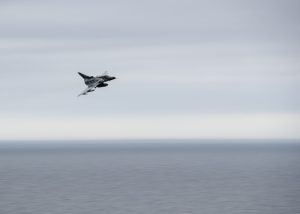The first-of-class nuclear-powered aircraft carrier USS Gerald R. Ford (CVN-78) conducted tests of a number of combat systems while underway in the Atlantic Ocean in March and April of this year, the U.S. Navy said in an April 7 statement.
The tests took place as part of the carrier’s post-delivery test and trials (PDT&T) phase and are designed to stress the Ford’s combat system capabilities and validate the integration of new defense technologies.
The carrier’s first certification of integrated combat systems tested the Air Traffic Control Radar Beacon (ATCRB) and Identification of Friend or Foe (IFF), according to the Navy. The tests were conducted over several days and evaluated the ATCRB’s ability to track air and surface contacts and to identify friendly and enemy aircraft using an advanced IFF system.
“SBDT is a stepping stone towards Ford’s Combat Systems Ship Qualification Trial (CSSQT), and follow-on operational tests by the Navy,” Commander William Buell, the carrier’s combat direction center officer, was quoted as saying. “Our SBDT operations ran very smoothly, which is a good indicator of future success on CSSQT.”
SBDT also included an up-load of simulated munitions for operators in the carrier’s Combat Direction Center (CDC) to simulate engaging the aircraft.
“It was encouraging to see the results of our collective labor pay off and prove the warfighting capability of the class,” a fire controlman was quoted as saying, according to the Navy press release. “Without these self-defense systems, Gerald R. Ford wouldn’t be able to deliver lethal effects to our nation’s adversaries.”
Last February, U.S. defense contractor Raytheon and the U.S. Navy conducted the first-ever live fire test of the Ford’s so-called Ship Self Defense System (SSDS) Integrated Combat System on the U.S. Navy’s Self Defense Ship.
A recent U.S. government report revealed problems with three combat systems of the Ford: the SLQ‑32(V)6 electronic warfare system, the SPY-3 Multi‑Function Radar (MFR), and the Cooperative Engagement Capability (CEC).
The Ford incorporates a number of untried new technologies including advanced weapons elevators, main turbine generators, a new dual-band radar system, a new advanced arresting gear, as well as a new electromagnetic aircraft launch system.
The carrier also completed its Flight Deck Certification (FDC) and Carrier Air Traffic Control Center (CATCC) Certification on March 20. Over a two-day period, F/A-18E and F/A-18F Super Hornets 8 conducted 123 day, and 42 night cats and traps (catapult launches and recoveries) aboard the carrier, according to the Navy.
The Ford, commissioned in July 2017, is the most expensive warship in U.S. Navy history, with total procurement cost amounting to around $13 billion.

































